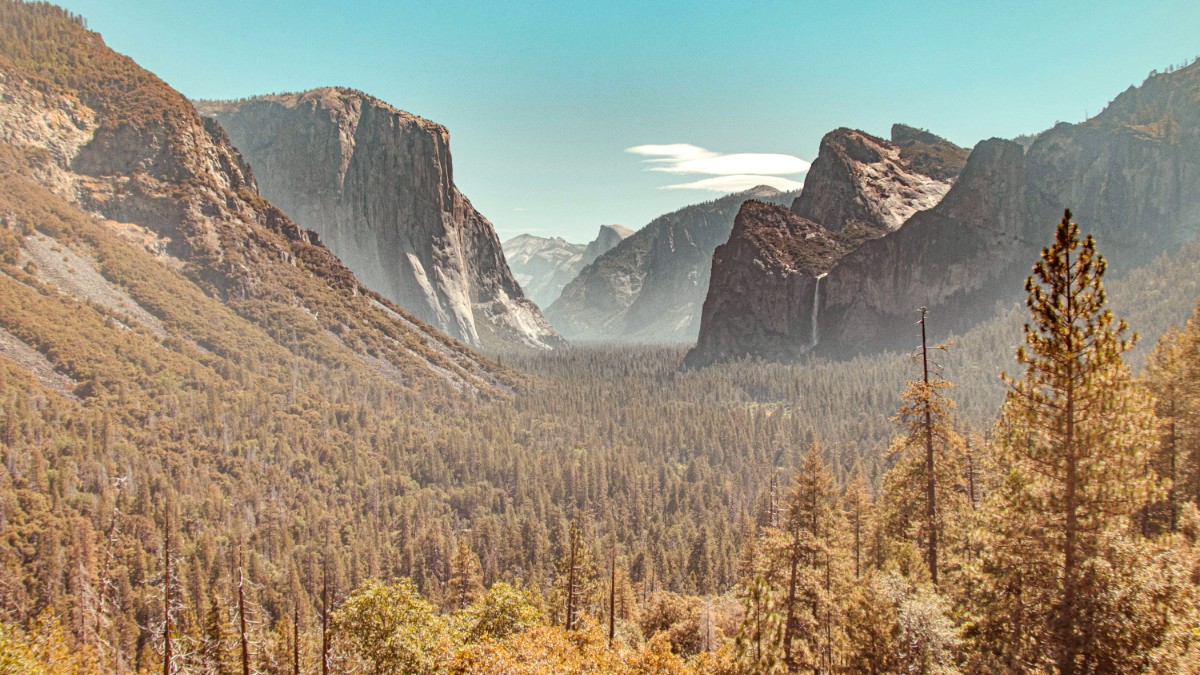
USA
These are the sights that define Yosemite and draw visitors from around the globe. The undisputed heart of the park is Yosemite Valley, an U-shaped glacial valley where most of Yosemite's iconic features reside. Its formation by ancient glaciers gives it its distinct shape and towering walls.
Specific landmarks include El Capitan, Half Dome, and Yosemite Falls.
Less crowded times: Winter (least crowded, snow views), Shoulder Seasons (fewer crowds than summer), Sentinel Dome/Taft Point (stunning views, fewer people than Glacier Point).
Yosemite insights into its human history and artistic inspiration through its museums and cultural spaces.
Focuses on cultural history of Yosemite's Miwok and Paiute people. Exhibits showcase traditional crafts, basketry, and a recreated Indian Village of Ahwahnee.
Outdoor museum in Wawona with historic buildings from early park settlement era (blacksmith shop, jail, log cabins).
Showcases iconic black-and-white photography of Ansel Adams and other contemporary artists; sells prints, books, and photographic supplies.
Yosemite deep spiritual significance for Miwok and Paiute people. Natural features hold spiritual meaning for many.
Park managed by U.S. Army Cavalry (1891-1914). Historical remnants and stories contribute to park's administrative heritage.
Ranger-led talks and cultural demonstrations often take place at visitor centers or the Indian Cultural Exhibit.
The Ahwahnee (National Historic Landmark) renowned for its architecture. Wawona Hotel a charming example of late 19th-century resort architecture.
Evidence of human occupation dates back over 8,000 years. Many sites are protected and not publicly accessible to preserve integrity.
Various plaques and monuments commemorate significant individuals who shaped Yosemite's history, like John Muir, and important conservation events.
The Indian Cultural Exhibit (Yosemite Village), part of the Yosemite Valley Museum, provides insights into Native American culture through exhibits and occasional demonstrations. Ranger-led evening programs often take place at outdoor amphitheaters or indoor auditoriums at various campgrounds and lodges.
Beyond the well-known landmarks, Yosemite's natural attractions offer diverse landscapes and wildlife viewing opportunities. The entire park a protected natural area, functioning as a vast wild space. Yosemite Valley itself, with its open meadows and river, serves as a grand natural park.
Discover unique perspectives and breathtaking vistas.
Observe Yosemite's diverse fauna in their natural habitat.
Witness the dramatic results of millions of years of geological activity.
Explore Yosemite's aquatic environments.
Plan ahead for a smooth visit.
Check for road closures, especially Tioga Road and Glacier Point Road, which are seasonal and closed during winter months.
Permits are for the Half Dome hike and wilderness backpacking. Secure these well in advance due to high demand.
Weather in Yosemite can change rapidly. Be prepared for varied conditions, especially in higher elevations.
Visit the Pioneer Yosemite History Center for a glimpse into early settler life. Explore the Indian Village of Ahwahnee for Miwok and Paiute culture.
Tunnel View offers classic panoramas. Explore Cook's Meadow Loop for wide compositions. Visit Ansel Adams Gallery for inspiration and prints.
Walk among giant sequoias in Mariposa Grove. Look for wildlife in Yosemite Valley meadows at dawn or dusk.
Take on the challenging Half Dome hike (permit required). Explore the less-traveled trails in Hetch Hetchy Valley for strenuous hikes and solitude.
Enjoy easy paved walks to Lower Yosemite Fall or Bridalveil Fall. Rent bikes for a leisurely ride on the Valley's paved paths.
Yosemite's beauty changes with the seasons.
Experience unique tranquility and stunning transformations.
Many viewpoints and sections of trails (e.g., Lower Yosemite Fall Trail) are wheelchair accessible.
Check the official NPS website for detailed accessibility information for specific attractions and facilities.
Beyond the main attractions, Yosemite's vast wilderness invites exploration and unique experiences.
Located in the northwestern part of the park, this controversial reservoir is a beautiful valley with impressive waterfalls and hiking trails, often less crowded than Yosemite Valley.
Explore distinct gateway towns which offer a different approach to the park and their own character.
The park's vast high country a less crowded escape, offering pristine wilderness and unique scenery when Tioga Road is open.
Access limited to the Tioga Road season (typically June to October).
Accessible via Glacier Point Road, these spots offer stunning views with fewer people than Glacier Point itself.
Popular spots for sunset, offering dramatic lighting for photography.
A less strenuous way to see many of the Valley's iconic features from various angles, avoiding the main shuttle stops.
The full loop a comprehensive view of the Valley's grandeur.
Ranger-led programs cover natural history, park management, geology, and cultural topics.
Often take place at outdoor amphitheaters or indoor auditoriums, suitable for all ages.
Consult the "Yosemite Guide" upon arrival for current schedules and locations.